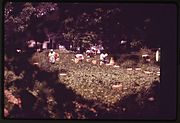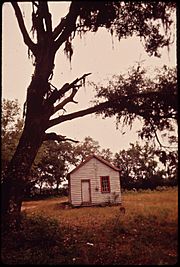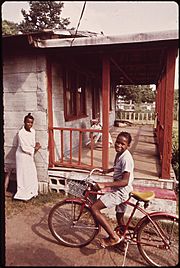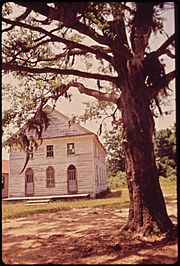Johns Island, South Carolina facts for kids
| Administration | |
|---|---|
| State | South Carolina |
| County | Charleston County |
Johns Island is a large island in Charleston County, South Carolina, United States. It's the biggest island in the state of South Carolina. Johns Island is surrounded by other islands like Wadmalaw, Seabrook, Kiawah, Edisto, Folly, and James. The Stono and Kiawah rivers separate Johns Island from these neighbors.
It's actually the fourth-largest island on the US east coast! Only Long Island, Mount Desert Island, and Martha's Vineyard are bigger. Johns Island covers about 84 square miles (220 km2) (218 square kilometers) and is home to around 21,500 people. The island got its name from Saint John Parish in Barbados. The first English settlers who came here were from that area.
Contents
Discovering Johns Island's Amazing Wildlife
Johns Island is a fantastic place for nature lovers! It's home to many different kinds of animals. You might spot deer, alligators, raccoons, coyotes, bobcats, otters, and even wild hogs.
The rivers and marshlands around the island are full of fish and shellfish, especially tasty oysters. You can often see playful dolphins swimming in the water. For bird watchers, there are hundreds of species to discover. Look out for majestic bald eagles, osprey, wild turkeys, owls, hawks, herons, egrets, and ducks. The island also has lots of plants, including native ones, those brought from other places, and many farm crops.
Johns Island's Past: A Journey Through Time
Early Days: The Colonial Era (1670–1776)
Long ago, Johns Island was home to Native American tribes like the Kiawah. They moved around, hunting and gathering shellfish to survive. By the time Europeans arrived, these tribes, including the Stono and the Bohicket, had settled down and were farming the land.
At first, the Stono people and the European settlers got along. However, their relationship became difficult after some events led to conflict. By the 1670s, European colonists started building small settlements near the water. Old maps from the late 1600s and early 1700s show farms, called plantations, along the Stono River. During this time, the main crop grown was indigo, which was very valuable for making a rich blue dye. These plantations relied on enslaved people to do the hard work of farming.
A very important event called the Stono Rebellion happened on Johns Island in 1739. It began when a group of enslaved people tried to escape to Spanish Florida, where they were promised freedom. Early on September 9, 1739, about 20 enslaved people met near the Stono River. They were led by a man named Jemmy. The group went to Hutchinson's Store, where they took food, weapons, and supplies. Sadly, the two shopkeepers lost their lives. The group then crossed the Stono River and gathered more followers as they walked towards Spanish Florida.
On their journey, they met Lieutenant Governor William Bull and four friends. Bull quickly gathered other plantation owners to stop the uprising. The planters chased after the enslaved people, attacking those who couldn't prove they were forced to join the march.
Fighting for Freedom: The American Revolution (1776–1785)
The American Revolutionary War reached Johns Island in May 1779. British troops, led by General Augustine Prevost, arrived. A smaller group of British soldiers, led by Lieutenant Colonel John Maitland, stayed on the island. More British troops, under Sir Henry Clinton, landed on Seabrook Island in February 1780.
Clinton's plan was to cross Johns Island and James Island to attack Charleston. His army crossed the Stono River and set up a temporary base at Fenwick Hall. They then moved to James Island, marched along the Ashley River, and headed south to Charleston. Clinton's army surrounded the city. Charleston surrendered to the British on May 12, 1780, and the British stayed until December 1782.
A Divided Nation: The Civil War (1861–1865)
The Battle of Bloody Bridge, also known as Burden's Causeway, took place on Johns Island in July 1864. This battle site is near River Road, just north of the Charleston Executive Airport. On July 2, 1864, Union troops, led by Brig. Gen. John Hatch, landed in the Legareville area of Johns Island. Hatch wanted to cross Johns Island, then the Stono River, to attack James Island.
The Union soldiers met Confederate troops where a creek turned into a swamp. About 2,000 South Carolina soldiers bravely held off a much larger Union force of about 8,000 men. After three days of fighting, Hatch's troops left the island.
Johns Island Today: A Growing Community
Johns Island is located west of James Island, east of Wadmalaw Island, and inland from Seabrook Island and Kiawah Island. It's separated from the mainland by the Stono River, which is part of the Intracoastal Waterway. About one-third of the island is part of the city of Charleston.
The island is famous for the Angel Oak, a huge Southern live oak tree. It's thought to be 400–500 years old! Johns Island is also known for its farms, which grow delicious tomatoes and many other crops. The island's population is growing quickly. Between 2000 and 2010, it grew by 50%, which was the biggest increase ever. This growth is expected to continue, but many groups are working to make sure new development is good for the environment.
Because it's close to downtown Charleston and has beautiful land, Johns Island is a popular spot for new buildings. Many new housing areas have been built in the parts of the island that are part of Charleston. Most of the island is still managed by Charleston County. You might be interested to know that some movies have been filmed here, including The Notebook (2004).
Cool Places to Visit on Johns Island
Johns Island Presbyterian Church
Johns Island Presbyterian Church on Bohicket Road was first built in 1719. It was part of a plan to create five Presbyterian churches in rural South Carolina. This church is special because it's one of the oldest churches in the United States built with a wood frame. The church was made bigger in 1792 and again in 1823. Today, you can visit the church and take tours. It's also listed on the National Register of Historic Places.
St John's Episcopal Church
This church was originally built in 1734 as part of the Church of England. The church building you see today was built in the 1950s. Earlier churches on the same spot were damaged during the Revolutionary and Civil Wars. In the mid-1800s, there were more Black members than White members, including many enslaved people. You can find graves from the colonial and Revolutionary War eras in the churchyard.
Hebron Center: A Church Built by Freedom
The Hebron Presbyterian Church on Johns Island was started in 1865, right after the Civil War ended. It was built near Gregg Plantation. The first building was finished in 1868. It was built by formerly enslaved carpenters and founding members of the church, Jackson McGill and John Chisholm. They used lumber found floating on Seabrook and Kiawah beaches after a shipwreck! Under the leadership of Reverend Ishmael Moultrie, the church grew from meeting under a simple bush tent to having a new building in April 1970.
This church was formed by a small group of freed slaves. They wanted their own church because the White leaders of the local Presbyterian church wouldn't help them. So, in 1867, they asked the Presbyterian leaders to establish a "Freedman’s church," a church built by and for Black people. The builders of Hebron Presbyterian Church didn't wait for official permission and completed their church.
Many Black people who attended the White Presbyterian church during slavery became members of the original Hebron Presbyterian Church. After the Reconstruction era, White Presbyterian churches in the South stopped including Black members. This led formerly enslaved people to find their own places to worship. Most of them wanted to stay with the Presbyterian faith, so they met in a bush tent, singing and praying. Reverend Moultrie then helped organize Black Presbyterian churches as mission churches to the Northern Presbyterian Church.
The construction of Hebron Church began in 1865. A storm blew a ship carrying timber onto a sandbank near Kiawah. When Reverend Moultrie heard about the shipwreck, he saw it as a gift from God. Moultrie was born on St. Helena Island and went to the Penn School, one of the first schools for freed slaves. He encouraged his church members to embrace their freedom by learning to read and write. His focus on education and his exciting preaching style made him very popular.
Moultrie sent the strongest members of the bush church to row out to the shipwreck. They collected the timber and slowly brought it to shore. Oxen carts then carried it across Hope Plantation to the spot where the first church built by and for freed slaves would stand. They named the church Hebron, after an ancient holy city mentioned in the Bible.
Jackson McGill and John Chisholm were skilled carpenters who had learned their trade while enslaved. The church building they created is a mortise and tenon timber-frame structure. It's one of the few left on Johns Island and is the oldest freestanding building built by freed slaves. They built a beautiful church with a front entrance area and balconies on three walls to fit as many people as possible. This building was the spiritual heart of the island's formerly enslaved population for almost 100 years. Then, the church moved to a newer building. The old Hebron Church remains one of Johns Island's most important landmarks.
The church grew, and in 1965, the members decided to build a new church. Each member contributed money, and fundraising continued until 1969, when construction began. Work was slow, as members built when they had time and money. In November 1976, the church moved to the new brick building, and the old church became empty.
In 1980, a group of Franciscan nuns helped turn the historic church into a senior citizens' center. They started the Hebron St Francis Senior Citizen Center, which offered help and a soup kitchen for older citizens in the empty Hebron Church building. By the mid-1980s, people of all faiths gathered at the old church for spiritual talks and food. A small kitchen was built where the altar used to be, and tables were filled with crafts. A quilting group was formed, making beautiful quilts from donated materials.
In 1989, Hurricane Hugo hit, damaging the church's foundation and making it lean a bit. The Franciscans left, and Alfreda Gibbs Smiley LaBoard took over. She became the heart of the Hebron group meeting in the damaged building. LaBoard became friends with Mary Whyte, a famous painter. One day, Whyte noticed that LaBoard's cornbread was burnt on one end because the church floor was slanted! Their friendship was written about in the book Afreda’s World. The book's fame led to donations of fabric for the quilters from all over the world, starting a small revival.
The building continued to get worse. Whyte and some Kiawah residents became worried and started raising awareness about this historic treasure. The church members and dedicated community members held their first Gullah Gala in 2003 to share the church's history and needs. Fundraising began with a candlelight service, with quilts hanging from the ceiling. The first goal was to fix the leaky roof and the tilting walls. This gave the church new hope. However, three years after the first gala, Alfreda LaBoard passed away. More than 600 people attended her funeral. In her eulogy, Reverend River described LaBoard's life as one of suffering, selfless service to others, and strength from faith. LaBoard also inspired Whyte and the architect hired for the restoration, Christopher Rose.
During the restoration, it was discovered that the wooden beams of the balcony floor had a special curve. This proved that parts of the shipwrecked schooner were indeed used to build the church, confirming the oral history passed down through generations. Today, the Hebron Presbyterian Church building is one of the oldest structures on Johns Island. It has unique architectural features created by the original carpenters.
Angel Oak: A Living Legend
The Angel Oak is a magnificent Southern live oak tree on Johns Island. While some once thought it was 1500 years old, experts now believe it's about 400 to 500 years old. The oak stands 65 ft (20 m) (20 meters) tall, and its trunk is 25.5 ft (7.8 m) (7.8 meters) around. Even though many people believe it's the oldest tree east of the Mississippi River, many baldcypress trees in the South are actually hundreds of years older.
The Angel Oak stands on land that was given to Jacob Waight in 1717. The City of Charleston bought the Angel Oak in 1991. Today, Angel Oak Park lets visitors get a close look at this amazing tree. The park also has a gift shop and picnic tables.
Mullet Hall Equestrian Center: Fun with Horses
Mullet Hall Equestrian Center is located on Mullet Hall Road on Johns Island. This huge center covers 738 acres (299 hectares) and has 20 miles (32 kilometers) of trails. It's a popular spot for horse riding competitions, festivals, and other events. Planning for the center started in 2000. It includes four show rings, a large Grand Prix ring, 40 acres of grass fields, 196 horse stalls, and areas for jumping and lunging.
Battle of Charleston Reenactment: History Comes Alive
An annual Battle of Charleston reenactment takes place at Legare Farms, off River Road on Johns Island. This event started in 2004. It includes exciting battle reenactments, food, music, and a chance to experience the culture of the 19th century. One of the battles reenacted is the Johns Island 1864 "Battle of Bloody Bridge." As of 2013, this event has become a "timeline" reenactment, showing battles from all American wars.
Besides the John's Island Presbyterian Church, the Moving Star Hall and The Progressive Club are also listed on the National Register of Historic Places.
Learning on Johns Island: Schools and Libraries
Schools on Johns Island
The Charleston County School District runs several public schools on the island:
- Angel Oak Elementary School
- Mount Zion Elementary School
- Haut Gap Middle School
- St. John's High School
There are also private schools:
- Charleston Collegiate School is a school that prepares students for college. It serves students from kindergarten (K4) through 12th grade.
- Capers Preparatory Christian Academy
- Montessori School of Johns Island is a Montessori school for children from 12 weeks to 12 years old. It's located off Main Road, near West Ashley.
Septima Poinsette Clark, a famous educator and civil rights activist, taught at Promise Land School from 1916 to 1919. She returned to Johns Island and taught children during the day. At night, she taught adults who couldn't read or write, on her own time.
Johns Island Branch Library: A Hub for Readers
The Johns Island Branch Library, located off Maybank Highway, is part of the Charleston County Public Library system. This large library opened in 2004 and cost $4.3 million to build. At 16,000 square feet, it's more than twice the size of the county's usual library branches. It was built to serve Johns Island, Wadmalaw Island, Kiawah Island, and Seabrook Island.
Connecting the Island: Bridges
Johns Island is connected to other areas by two important bridges:
|






